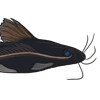So, my first official NZ collecting trip was at the Garry River, a tributary of the Ashley River in Canterbury. You can see the location if you enter "Hayland Road, Canterbury, New Zealand" into Google Maps (use the "terrain" or "satellite" setting).
The Kit:

Collecting bucket (must be watertight)
Trout fishing landing net (need to get/make a good push net though)
Photo tank - a clear refrigerator door compartment (won't break, but not very clear)
Electronic pH and conductivity meters
Waterproof paper and pencil
Scissors
GPS
Preserving jar
MS-222 (fish anaesthetic)
Formalin (10%)
Sample tubes filled with 100% ethanol for DNA samples
Sandfly repellent (DEET)
Rod and reel for larger and more delicious fishes
Camera (was hard to include this in the photo
Location One:
Small, shallow, steep gradient stream. Boulder/gravel/sand substrate.
Temperature: 12.0C
Conductivity: 115us
pH: 7.8



I was very excited with my first fish, as it looked like a weird galaxiid in the net. Unfortunately it was a non-native brown trout (Salmo trutta), and too small to eat! This was the only fish caught at this location.
Location Two:
Low gradient braided riffle/pool stream. Stones/gravel/sand substrate.
Temperature: 13.6C
Conductivity: 121us
pH: 7.6


Looks shallow, but was actually well over 1m deep under the tree.

At last, a native fish. Upland bully (Gobiomorphus breviceps), female.

Head shot of same fish. Gobiomorphus belong to the family Eleotridae (sleepers, or sleeper "gobies").

Head shots of male (right) and female (left). Males have much more bulbous heads and brighter colours.

Again, male (right) and female (left). These were found under stones in shallow water.

Male

Male

Male

Male

These young galaxiids were found in deeper water under the tree. I think they are Galaxias maculatus, but I need to do some more research on that, as some features don't seen to match.

The mesh of my net was too big for these guys, but luckily I managed to hang on to some. They were midwater swimming, but associated with the cover of the tree branches/roots.

Also of interest - a big old fishing spider (Dolomedes sp.) found under a rock.






